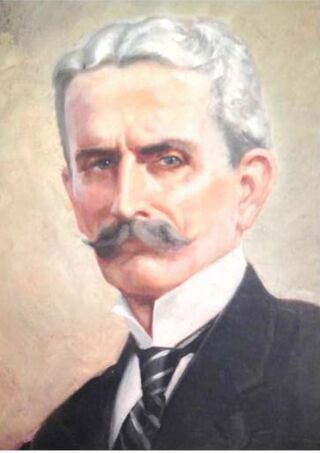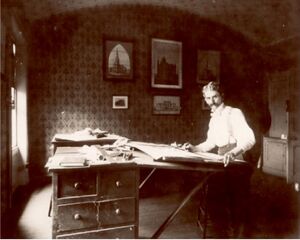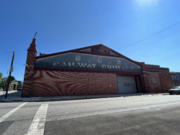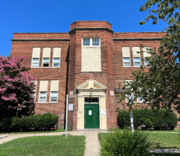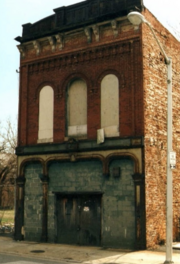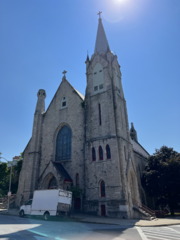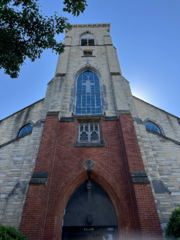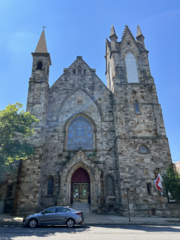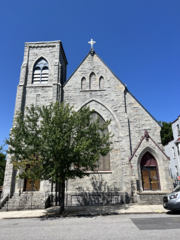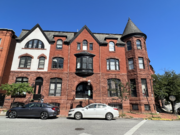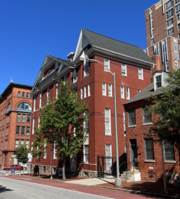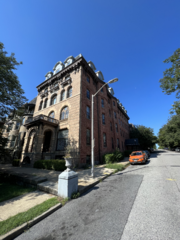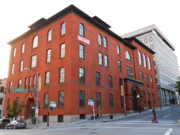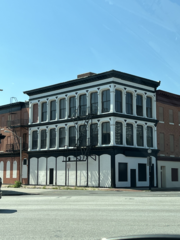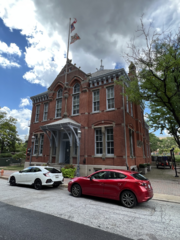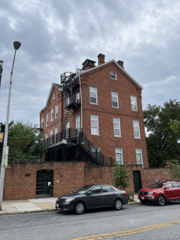Difference between revisions of "Frank E. Davis"
| (3 intermediate revisions by the same user not shown) | |||
| Line 7: | Line 7: | ||
|death_approx=No | |death_approx=No | ||
|death_place=Los Angeles, California | |death_place=Los Angeles, California | ||
| + | |significant_design=First English Reformed Church; Old Town Savings Bank; First English Lutheran Church; Grace Methodist Episcopal Church; Pine Street Police Station; Holy Innocents Protestant Episcopal Church | ||
}} | }} | ||
{{Biography}} | {{Biography}} | ||
| − | Francis Earlougher Davis was born in | + | Frank E. Davis, née Francis Earlougher Davis, was born August 14, 1839 in Ellicott’s Mills, Maryland. His father was a wagonmaker and ornamental blacksmith, and his mother was the daughter of an innkeeper in Ellicott’s Mills. His early architectural training likely came from his uncle, Charles Timanus, who was the architect and builder of the Howard County Courthouse, which was erected in Ellicott’s Mills and completed in 1843. Around the time Davis was eighteen, he started an apprenticeship under Edmund G. Lind, who was a prominent Baltimore architect. Before and during the Civil War, Davis studied at the Maryland Institute (now MICA) and was accepted into their Architectural Class in 1861. |
| − | + | In 1864, he moved to Washington, DC to apprentice as a draftsman in the Office of the Supervising Architect for the United States Treasury Department. In 1865, he created a firm with Thomas Dixon, known as Dixon & Davis. Together they designed the First English Reformed Church and other buildings. They had a downtown office until the firm dissolved in 1868. | |
| − | In | + | In 1867, Davis married Emma Eudora Small after a long period of courtship. But she died in 1873, when she was only 29 years old. |
| − | + | During their marriage, Davis designed several buildings that came to fruition, such as Engine House #8 and the Old Town Savings Bank. In 1870, he was elected to the Baltimore chapter of the American Institute of Architects (AIA). In the years after Emma’s death, he had his most productive period. Between 1874 and 1882, he designed several building that are extant today: Saint Michael’s Church Convent, First English Lutheran Church, Grace Methodist Episcopal Church, Pine Street Police Station, BCP Railway Car Barn and Offices, Holy Innocents Protestant Episocal Church, Male Grammer & Primary School No. 1, and Clifton School. In 1875, the State Normal School on Lafayette Square was built to his design, and while this work was considered one of his most recognizable, it has since been demolished. | |
| − | + | [[File:Davis At his Drafting Table in his Home 802 N Carrollton Ave.jpg|frameless]] | |
| − | + | In 1983, Davis got married a second time to Annie Legate Swindell. Their ceremony was held at Grace Methodist Episcopal Church, which he himself designed, and they moved into a house catty-corner from the church, on the southwest corner of Lafayette Square, in a row of homes also designed by him. Together they had five children—four boys and one girl. His eldest son, Francis Pierpont Davis, went on to be a prominent architect in Los Angeles, California. | |
| + | |||
| + | After starting a family, Davis’ practice slowed down. He designed the Maryland Bicycle Club (1885), townhouses for James Thompson (1885), and an Odd Fellows Hall (1891), but most of his projects were behind him. In 1912, he retired, and he moved to Los Angeles with his wife in 1915 to be closer to two of their sons. Most of his projects were in Maryland, though he also worked in West Virginia, Virginia, Pennsylvania, and Delaware. His career is notable for its range. He designed residences and businesses, as well as religious, cultural, educational, medical, and governmental buildings. He died on April 19, 1921. | ||
| + | |||
| + | By Dom Guida, with research done by Helen Hinchliff and Carlos Avery{{NewArchitectPageFormat}} | ||
==Biography== | ==Biography== | ||
[[Category:Architects|Davis, Frank E.]] | [[Category:Architects|Davis, Frank E.]] | ||
Latest revision as of 15:54, August 18, 2022
Biography
Frank E. Davis, née Francis Earlougher Davis, was born August 14, 1839 in Ellicott’s Mills, Maryland. His father was a wagonmaker and ornamental blacksmith, and his mother was the daughter of an innkeeper in Ellicott’s Mills. His early architectural training likely came from his uncle, Charles Timanus, who was the architect and builder of the Howard County Courthouse, which was erected in Ellicott’s Mills and completed in 1843. Around the time Davis was eighteen, he started an apprenticeship under Edmund G. Lind, who was a prominent Baltimore architect. Before and during the Civil War, Davis studied at the Maryland Institute (now MICA) and was accepted into their Architectural Class in 1861.
In 1864, he moved to Washington, DC to apprentice as a draftsman in the Office of the Supervising Architect for the United States Treasury Department. In 1865, he created a firm with Thomas Dixon, known as Dixon & Davis. Together they designed the First English Reformed Church and other buildings. They had a downtown office until the firm dissolved in 1868.
In 1867, Davis married Emma Eudora Small after a long period of courtship. But she died in 1873, when she was only 29 years old.
During their marriage, Davis designed several buildings that came to fruition, such as Engine House #8 and the Old Town Savings Bank. In 1870, he was elected to the Baltimore chapter of the American Institute of Architects (AIA). In the years after Emma’s death, he had his most productive period. Between 1874 and 1882, he designed several building that are extant today: Saint Michael’s Church Convent, First English Lutheran Church, Grace Methodist Episcopal Church, Pine Street Police Station, BCP Railway Car Barn and Offices, Holy Innocents Protestant Episocal Church, Male Grammer & Primary School No. 1, and Clifton School. In 1875, the State Normal School on Lafayette Square was built to his design, and while this work was considered one of his most recognizable, it has since been demolished.
In 1983, Davis got married a second time to Annie Legate Swindell. Their ceremony was held at Grace Methodist Episcopal Church, which he himself designed, and they moved into a house catty-corner from the church, on the southwest corner of Lafayette Square, in a row of homes also designed by him. Together they had five children—four boys and one girl. His eldest son, Francis Pierpont Davis, went on to be a prominent architect in Los Angeles, California.
After starting a family, Davis’ practice slowed down. He designed the Maryland Bicycle Club (1885), townhouses for James Thompson (1885), and an Odd Fellows Hall (1891), but most of his projects were behind him. In 1912, he retired, and he moved to Los Angeles with his wife in 1915 to be closer to two of their sons. Most of his projects were in Maryland, though he also worked in West Virginia, Virginia, Pennsylvania, and Delaware. His career is notable for its range. He designed residences and businesses, as well as religious, cultural, educational, medical, and governmental buildings. He died on April 19, 1921.
By Dom Guida, with research done by Helen Hinchliff and Carlos Avery
Projects
Map
| Library |
Church |
Government |
Commercial |
Dwelling |
Park |
Educational |
|---|
Listing
| Project | Completed | Address | Image |
|---|---|---|---|
| Project | Completed | Address | Image |
| Baltimore County School No. 7 | 1882 | 200 Ashland Rd. | |
| BCP Railway Car Barn and Offices | 1879 | 2560 Madison Ave | |
| Clifton School | 1882 | 2670 Kennedy Ave | |
| Engine House No. 8 | 1871 | 1031 W Mulberry St | |
| First English Lutheran Church | 1875 | 823 W Lanvale St | |
| First English Reformed Church (Aisquith Street) | 1867 | 417 Aisquith St | |
| Grace Methodist Episcopal Church | 1876 | 1121 W Lanvale St | |
| Holy Innocents Protestant Episcopal Church | 1880 | 1100 N Eden St | |
| James Thompson Townhouses | 1885 | 206 Laurens Street | |
| Male Grammar & Primary School No. 1 | 1880 | 520 W Fayette St | |
| Maryland Bicycle Club | 1885 | 2028 Mt Royal Terrace | |
| Odd Fellows Hall | 1891 | 300 Cathedral St | |
| Old Town Savings Bank | 1871 | 353 N Gay St | |
| Pine Street Police Station | 1877 | 214 N Pine St | |
| Saint Michael’s Church Convent | 1874 | 1901 E Lombard St |
